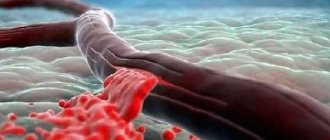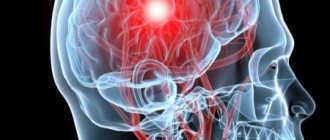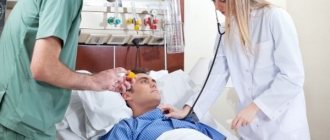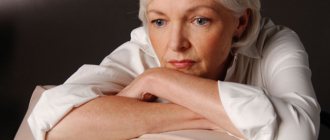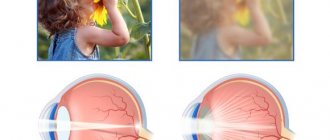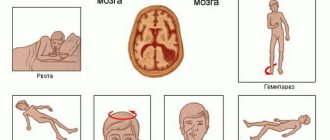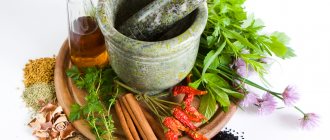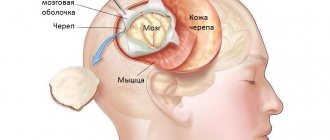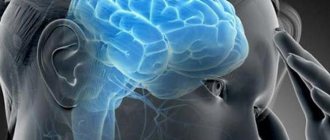General rules
Ischemic stroke is a condition that develops as a result of a decrease in blood supply to the brain in any arterial system.
This leads to ischemia of this area and a focus of brain tissue necrosis is formed. Clinically, this is characterized by the appearance of persistent (more than 24 hours) focal symptoms, which correspond to damage to the vascular system and the identification of an acute cerebral infarction on CT or MRI. The most common cause of ischemic stroke is thrombosis or embolism against the background cerebral atherosclerosis With lesions of large arteries, fairly extensive cerebral infarctions develop with severe symptoms and a severe course. When small arteries are damaged, a microstroke - heart attacks with small lesions, so the disorders are hardly noticeable and their recovery occurs quickly. This may include numbness of the face, dizziness or sudden headache , poor coordination of movements, intolerance to bright light and loud sounds. Often patients do not pay attention to this and are left without the necessary treatment.
Treatment includes basic therapy (maintaining blood pressure, normalizing breathing, regulating homeostasis , reducing cerebral edema, eliminating hyperthermia) and specific therapy - thrombolysis , antiplatelet therapy, anticoagulant therapy (if indicated) and even surgical treatment. Nutrition is also an important point. What should be the diet for a stroke?
In case of depression of consciousness or impaired swallowing, nutrition in the hospital is carried out using a tube with special mixtures ( Nutrizon , Berlamin , Nitridrink ), the energy value of which ranges from 1800-2400 kcal. For each patient, the daily amount of protein, fats and carbohydrates is calculated and a certain amount of the mixture is administered.
Food and meals can be administered through the tube. Lean boiled meat and fish are allowed, which are passed through a meat grinder twice and rubbed through a sieve. The resulting puree is mixed with the pureed side dish and the broth is added until the desired consistency passes through the probe. The patient receives 50 g of fish and 150 g of meat, 200 ml of kefir, 600 ml of milk, 150 g of cottage cheese, 50 g of sour cream per day. Porridges are prepared pureed, diluted with milk or broth.
Potatoes, carrots, beets, cauliflower, zucchini, and pumpkin are well boiled and pureed. When it becomes possible to swallow, the patient is transferred to self-feeding: liquid cereals, juices, fruit and vegetable purees, soups with meat, chopped in a blender. Drinks allowed include tea with milk, cocoa with milk, juices, and rosehip infusions.
The diet for ischemic stroke must comply with the recommendations of the treatment table 10C , which is prescribed for vascular atherosclerosis. This therapeutic nutrition is aimed at normalizing lipid metabolism and slowing the progression of atherosclerosis . Contains a physiological amount of proteins, limited animal fat, simple carbohydrates and table salt (4-5 g). The food is enriched with vegetable oils, which contain polyunsaturated fatty acids and dietary fiber (cereals, vegetables and fruits).
Thus, nutrition after an ischemic stroke is based on the following principles:
- normalization cholesterol , since the main cause of stroke is atherosclerosis and lipid metabolism disorders;
- caloric restriction due to sugar and baked goods;
- control blood pressure by reducing salt in the diet. Food is prepared without it and it is allowed to add 4-5 g to dishes;
- complete vitamin composition (especially folic acid , vitamins B6 , B12 , E );
- fluid consumption up to 1.2 l;
- butter is allowed up to 20 g per day and up to 30 g of vegetable oil;
- Regular meals are recommended (up to 5 times a day) to avoid hunger;
- if you are overweight, significantly limit or completely eliminate sugar, flour and cereal dishes;
- Drinks that stimulate the central nervous system (alcohol, strong tea and coffee) are limited.
Now let's talk more about these points. Proper nutrition consists of reducing the consumption of animal fats and eliminating the intake of cholesterol from food. At the same time, it is necessary to increase the consumption of dietary fiber from cereals, vegetables and fruits. Dietary fiber absorbs excess cholesterol and removes it through the intestines.
Complex carbohydrates from fresh vegetables, fruits and grains normalize energy metabolism, which is important after a stroke, are digested slowly and create a feeling of satiety. Preference should be given to vegetables and fruits of purple and red color (they contain anticyanidins , which reduce capillary permeability): grapes, pomegranate, eggplant, red cabbage, sweet red pepper, beets.
With cerebrovascular accidents, hypertension and atherosclerosis, the need for omega-3 . They are essential and are not synthesized in the body. The daily need for them is 1-2 grams. The largest amount of linolenic acid is found in flax seeds, and sources of eicosapentaenoic and docosahexaenoic acids are fish oil, sea fish, tuna, herring, sardines and salmon. That is why the diet of patients should be dominated by vegetable oils and sea fish, which are better to replace meat in the diet.
Also important is the presence of vitamin E , the source of which is sea fish and vegetable oils, soy, milk, and herbs. Vitamin B6 is very useful , which we get from fruits, vegetables and whole grains: broccoli, spinach, carrots, seeds, wheat germ, corn, legumes. The action of B6 is to reduce homocysteine , which plays a significant role in the occurrence of ischemia.
Vitamins B6 and B12 help suppress homocysteine, but folic acid is more effective in this regard. Its intake of 400 mcg per day or more is necessary to reduce the risk of recurrent stroke. With its deficiency, homocysteine quickly accumulates in the blood. The leaders in folic acid content are cabbage, broccoli, beans, lentils, and citrus fruits.
After a stroke, a person is limited in movement and weight gain is noted. Extra calories come from baked goods and sweets. Replace wheat bread with bran bread, you will have to give up pancakes, pies and buns, instead of sweets, allow yourself honey, fruits and dried fruits, the benefits of which are much greater than in cakes and pastries. Sugar is allowed up to 50 g per day. To control your weight, you need to weigh yourself once every two weeks. From time to time you need to arrange fasting days: kefir or curd days, and in season - cucumber and watermelon days.
In case of hemorrhagic stroke, which occurs against the background of high blood pressure, the basic principles of nutrition are the same, but of particular importance is the limitation of salt, which binds and retains fluid in the body, which leads to an even greater increase in pressure and stress on the cardiovascular system. In this case, food is prepared without salt, and it is used in the amount of 2-4 g in ready-made dishes.
The second distinctive point of nutrition in this form of stroke is limiting fluid intake to 1.2 liters per day and excluding coffee, strong tea, various tonic drinks and stimulants (ginseng, Eleutherococcus, etc.) from the diet. To some extent, a decoction of diuretic herbs, valerian, hawthorn, beetroot juice and chokeberry help reduce blood pressure. Maintaining potassium and magnesium levels in the blood is of great importance. These microelements are found in rice, millet, prunes, dried apricots, raisins, oatmeal, cauliflower and white cabbage, bran bread, nuts, and beef.
Diet after a stroke at home
How to create a menu for a patient who has had a stroke? The duration of treatment in a hospital may vary, but most often patients return home within six days after the onset of the disease.
It is necessary to limit the consumption of animal fats. This will help reduce cholesterol levels in the blood, cleanse blood vessels from atherosclerotic plaques and restore physiological blood flow in the arteries.
To provide them with complete and balanced nutrition at home, as well as take into account the compatibility of products, you can use ready-made diets. One of them is table 10. This diet is designed for patients suffering from cardiovascular diseases; it includes foods that improve blood circulation and strengthen the heart and blood vessels. Table 10 is suitable for men and women.
Principles of dietary table No. 10:
- fractional meals - 5-6 meals a day in small portions;
- consumption of carbohydrates no more than 400 g per day, proteins - about 90 g per day, fats - about 70 g per day;
- liquid – up to 1.2 liters per day.
Any fried and fatty foods, fast food are not recommended for patients after a stroke
Authorized Products
It is better to eat rye bread, but wheat bread is also allowed, as well as with bran, peeled and whole grain flour. You can afford dry cookies, homemade savory pastries made from whole grain flour with bran and stuffed with cottage cheese, cabbage or fish.
Vegetable soups, cabbage soup, beetroot soup, borscht, and soups with cereals are allowed. However, they need to be cooked in water or vegetable broth. Meat and poultry should be selected from low-fat varieties and served boiled or baked. Therapeutic nutrition for this disease involves the predominance of fish and seafood in the diet, which should replace meat dishes. If you eat meat, then to reduce the extractive substances in it, you must first boil it and then bake or fry it.
It is better to prepare side dishes from vegetables: cabbage, beets, eggplants, pumpkins, carrots, zucchini and potatoes. It is better to make a mix of vegetables in the form of a stew. Fresh, you can make a variety of salads with the addition of healthy flax seeds and vegetable oils, which are best changed. Include vegetables rich in folic acid: lettuce, asparagus, broccoli, cauliflower, corn, pumpkin, beets, celery, carrots.
Milk and fermented milk should be consumed with low fat content, low-fat cottage cheese can serve as breakfast, and low-fat sour cream should be added only to dishes. Eggs are allowed up to 4 eggs per week, while protein can be eaten more often (in the form of protein omelettes). Porridges are prepared from buckwheat, barley, oatmeal, and millet cereals; they can be added to krupeniki (casseroles with cottage cheese). If you are obese, cereals and flour products should be limited. Butter (20 g per day) and vegetable oils (30 g) are allowed; they are used in dishes.
Fruits and berries can be consumed raw, as well as in compotes and jellies. Prefer fruits rich in potassium: dried apricots, dates, raisins, prunes, apples.
You can drink weak tea with milk, coffee substitute (coffee drinks, chicory), vegetable and berry juices. A daily intake of rosehip and wheat bran decoction is recommended.
Table of permitted products
| Proteins, g | Fats, g | Carbohydrates, g | Calories, kcal | |
Vegetables and greens | ||||
| greenery | 2,6 | 0,4 | 5,2 | 36 |
| eggplant | 1,2 | 0,1 | 4,5 | 24 |
| zucchini | 0,6 | 0,3 | 4,6 | 24 |
| cabbage | 1,8 | 0,1 | 4,7 | 27 |
| broccoli | 3,0 | 0,4 | 5,2 | 28 |
| Brussels sprouts | 4,8 | 0,0 | 8,0 | 43 |
| cauliflower | 2,5 | 0,3 | 5,4 | 30 |
| bulb onions | 1,4 | 0,0 | 10,4 | 41 |
| carrot | 1,3 | 0,1 | 6,9 | 32 |
| cucumbers | 0,8 | 0,1 | 2,8 | 15 |
| salad pepper | 1,3 | 0,0 | 5,3 | 27 |
| salad | 1,2 | 0,3 | 1,3 | 12 |
| beet | 1,5 | 0,1 | 8,8 | 40 |
| celery | 0,9 | 0,1 | 2,1 | 12 |
| asparagus | 1,9 | 0,1 | 3,1 | 20 |
| tomatoes | 0,6 | 0,2 | 4,2 | 20 |
| Jerusalem artichoke | 2,1 | 0,1 | 12,8 | 61 |
| pumpkin | 1,3 | 0,3 | 7,7 | 28 |
| lentils | 24,0 | 1,5 | 42,7 | 284 |
Fruits | ||||
| avocado | 2,0 | 20,0 | 7,4 | 208 |
| oranges | 0,9 | 0,2 | 8,1 | 36 |
| pomegranate | 0,9 | 0,0 | 13,9 | 52 |
| grapefruit | 0,7 | 0,2 | 6,5 | 29 |
| pears | 0,4 | 0,3 | 10,9 | 42 |
| kiwi | 1,0 | 0,6 | 10,3 | 48 |
| lemons | 0,9 | 0,1 | 3,0 | 16 |
| mango | 0,5 | 0,3 | 11,5 | 67 |
| tangerines | 0,8 | 0,2 | 7,5 | 33 |
| nectarine | 0,9 | 0,2 | 11,8 | 48 |
| peaches | 0,9 | 0,1 | 11,3 | 46 |
| apples | 0,4 | 0,4 | 9,8 | 47 |
Berries | ||||
| gooseberry | 0,7 | 0,2 | 12,0 | 43 |
| Red currants | 0,6 | 0,2 | 7,7 | 43 |
| black currant | 1,0 | 0,4 | 7,3 | 44 |
Nuts and dried fruits | ||||
| cashew | 25,7 | 54,1 | 13,2 | 643 |
| sesame | 19,4 | 48,7 | 12,2 | 565 |
| flax seeds | 18,3 | 42,2 | 28,9 | 534 |
| fenugreek seeds | 23,0 | 6,4 | 58,3 | 323 |
| sunflower seeds | 20,7 | 52,9 | 3,4 | 578 |
Cereals and porridges | ||||
| buckwheat (kernel) | 12,6 | 3,3 | 62,1 | 313 |
| oat groats | 12,3 | 6,1 | 59,5 | 342 |
| oat bran | 8,0 | 4,0 | 10,0 | 110 |
| cereals | 11,9 | 7,2 | 69,3 | 366 |
| barley grits | 10,4 | 1,3 | 66,3 | 324 |
Bakery products | ||||
| bread | 7,5 | 2,1 | 46,4 | 227 |
Confectionery | ||||
| Maria cookies | 8,7 | 8,8 | 70,9 | 400 |
Raw materials and seasonings | ||||
| honey | 0,8 | 0,0 | 81,5 | 329 |
Dairy | ||||
| skim milk | 2,0 | 0,1 | 4,8 | 31 |
| soy milk | 3,3 | 1,8 | 5,7 | 54 |
Cheeses and cottage cheese | ||||
| cottage cheese 0.6% (low fat) | 18,0 | 0,6 | 1,8 | 88 |
| curd tofu | 8,1 | 4,2 | 0,6 | 73 |
Meat products | ||||
| beef | 18,9 | 19,4 | 0,0 | 187 |
| rabbit | 21,0 | 8,0 | 0,0 | 156 |
Bird | ||||
| chicken fillet | 23,1 | 1,2 | 0,0 | 110 |
| turkey | 19,2 | 0,7 | 0,0 | 84 |
Fish and seafood | ||||
| fish | 18,5 | 4,9 | 0,0 | 136 |
| squid | 21,2 | 2,8 | 2,0 | 122 |
| mussels | 9,1 | 1,5 | 0,0 | 50 |
| seaweed | 0,8 | 5,1 | 0,0 | 49 |
Oils and fats | ||||
| butter | 0,5 | 82,5 | 0,8 | 748 |
| linseed oil | 0,0 | 99,8 | 0,0 | 898 |
| olive oil | 0,0 | 99,8 | 0,0 | 898 |
| sunflower oil | 0,0 | 99,9 | 0,0 | 899 |
Non-alcoholic drinks | ||||
| mineral water | 0,0 | 0,0 | 0,0 | — |
| green tea | 0,0 | 0,0 | 0,0 | — |
| * data is per 100 g of product | ||||
Nutrition for cerebral stroke, general principles
A cerebral stroke is an acute disease in which necrosis of an area of the brain occurs due to disruption of blood flow and nutrition of nerve tissue. Most often this occurs due to thrombosis (either blood clots or atherosclerotic plaques).
By following the correct diet and eating only healthy foods, the rheological properties of the body are restored (the composition and quality of the blood are normalized), which allows for the prevention of recurrent strokes, and will also speed up the recovery period after an illness.
In case of a cerebral stroke, it is recommended to use the Pevzner dietary table No. 10.
Its basic principles are a slight reduction in the caloric content of food, a sharp reduction in the consumption of light carbohydrates, a reduction in animal fats and salt for at least 3 months after a vascular accident. At the same time, there should be sufficient amounts of clean water, protein foods and fiber.
Food should be boiled, baked in the oven or steamed (in a double boiler or slow cooker). Fried foods should be completely excluded from the diet of such patients.
Allowed and prohibited foods of table No. 10 for cerebral stroke
Diet No. 10 includes permitted and prohibited foods, strict adherence to which will maximize the patient’s quality of life and shorten the rehabilitation period.
Useful and recommended foods and dishes for stroke:
- Vegetables: asparagus, broccoli, spinach, cauliflower, beets, carrots, zucchini, cucumbers, lettuce, tomatoes, pumpkin, dill, parsley. For the first 3 weeks (acute period), these vegetables should be heat-treated, chopped as much as possible, and pureed. Cream soup is also available. In the subacute period (up to 3 months), these products can be eaten in whole pieces, or in the form of salads in vegetable oil, or eaten raw.
- Fruits and berries: blueberries, cranberries, oranges, tangerines, sweet apples, peaches, apricots, cherries, kiwi, etc. In the acute period, weak compotes and juices without sugar, fruit purees, puddings, and jelly are allowed. In subacute cases, light sweetening with fructose, stevia or honey is allowed. You can also consume these products raw.
- Meat: chicken, turkey, veal, lean young pork. During the first three weeks of the disease, patients are given weak broths; some meat can be pureed; if the patient is able to eat whole pieces, then they can be finely chopped and given as is. In the subacute period, steam cutlets are added.
- Dairy products: milk, kefir, yogurt, fermented baked milk, homemade unsweetened yogurt, white unsalted cheese, cottage cheese. It is necessary to consume daily in sufficient quantity.
- Eggs. You are allowed to consume no more than 1 egg white daily. Yolk is prohibited in the acute period; in the subacute period, no more than 1 piece is allowed. in Week. Further - as desired (if you consume enough protein)
- Fish: any fish, consumed without skin, can be in the form of broths, soups, boiled, baked, in the form of steam cutlets, etc.
- Porridges and cereals: buckwheat, brown rice, red and black rice, oatmeal, pearl barley, barley, millet. In the acute period, they should be viscous, without salt and sugar, with water or milk. In the subacute period, more crumbly porridges are allowed; they can be sweetened with a small amount of fructose or honey, and also lightly salted (almost not noticeable by the taste buds). Regular addition of salt to food is possible 3-5 months after a stroke. It is prohibited to oversalt food.
- Bread and pastries. Products made from wholemeal flour (whole grain wheat flour, rye, corn, buckwheat, oatmeal) are allowed: bread, cookies, buns, pasta - after the end of the acute period of the disease. They should be slightly under-salted; a moderate amount of fructose can be added as a sweetener. In the acute period, you are allowed to eat 1-2 pieces of bread before going to bed. White flour products made from premium and first grade flour (including durum flour) are prohibited for life.
- Vegetable oils: olive, soybean, corn, etc. Add to dishes, and also take 1-2 tablespoons daily.
- Drinks: light compotes, juices, herbal decoctions (herbal teas) without sugar for the first 3 weeks, then on fructose or with honey + at least 1.5 liters of purified water per day on an empty stomach for the first 3 weeks, then 2 liters.
Dangerous and not recommended products for stroke:
- Legumes: peas, soybeans, beans, etc. Prohibited for use in the acute and subacute period of the disease. In the future, use in small quantities is possible.
- Fatty meats: duck, goose, lamb, fatty pork, etc. are prohibited for the first 3-6 months after a stroke. Allowed to be introduced into the diet after replenishing an acute protein deficiency
- Animal fats: lard, butter. Strictly prohibited in the acute period; in minimal quantities it can be introduced into the diet (as a topping for porridge) in the second half of the subacute period.
- Mushrooms – prohibited in acute and subacute periods
- Flour products made from white wheat flour (including high-quality durum flour): white bread, pastries, pastries and cakes, pasta. Prohibited for life, replaced with products made from wholemeal flour or rye, corn, buckwheat and oatmeal.
- Potatoes, bananas, raisins, grapes, beet sugar and white rice (contain light carbohydrates): prohibited for life
- Spicy food: prohibited in acute and subacute periods, limited in the first year after the disease
- Salt: completely excluded in the acute period and gradually introduced in the subacute period (up to 5 g per large pan of the finished dish)
- Pickled and fermented foods: prohibited for the first 3 months after a stroke
- Drinks: black and green tea, natural coffee, cocoa, chocolate, carbonated drinks, grape juice. Prohibited for at least 3 months after the onset of the disease, limited thereafter.
- Dairy products: hard cheese, cream, sour cream. Prohibited in the acute period and gradually, in small quantities, introduced in the subacute period.
- Egg yolk: prohibited in the acute period and gradually, in small quantities, introduced in the subacute period.
- Vegetables: radish, radish, garlic, sorrel: prohibited in the acute and subacute periods, subsequently they can be consumed as usual.
Read more about protein foods for cerebral stroke
Proteins and their components (replaceable and essential amino acids) are extremely necessary during the rehabilitation period and throughout the patient’s subsequent life.
They ensure the maximum possible restoration of brain cells, as well as all body functions.
Also, protein foods help prevent recurrent strokes by reducing the effects of atherosclerosis (they normalize the transport of cholesterol protein to the necessary cells and tissues, preventing its deposition on the walls of blood vessels).
In the first 3 weeks (acute period), the patient is allowed somewhat low-fat dairy products (milk, cottage cheese, white cheese, etc.), lean meats (chicken, turkey, veal, lean pork) in the form of broths, in vegetable purees or finely chopped pieces, fish without skin, cooked in any way (except fried), egg white (no more than 1 per day).
In the subacute period (up to 3 months after a stroke), steamed meat cutlets are added, and sour cream, cream and other fatty dairy products are gradually introduced in small quantities.
After this period, the variety of protein foods is gradually brought to the usual level, but it is necessary to look at the individual characteristics of the patient and the speed of his recovery and tolerance of the food consumed.
It is also highly recommended not to save on the amount of protein; its daily consumption should be at least 100 g per day.
Read more about fatty foods for cerebral stroke
Fatty foods and fats in their composition, no matter what, should be present in the diet of post-stroke patients. They provide the necessary level of hormones, participate in heat exchange, respiration and the construction of the membranes of all cells.
However, the first three months should slightly reduce the consumption of such food due to acute lack of protein and atherosclerosis in heart attack patients, on average about 60-70 g daily.
This is achieved by consuming lean meats and low-fat dairy products, egg yolk (no more than once a week in the subacute period), as well as vegetable oils (alternate several oils, add them to all dishes and drink the remaining amount yourself).
Animal fats (lard and butter) are strictly prohibited in case of protein deficiency; they are introduced gradually and in minimal dosages from the second half of the subacute period. Full dosages of fats in the patient’s menu are possible after eliminating the deficiency of amino acids in the body. As a rule, with proper nutrition, this occurs 8-12 months after a stroke.
More about carbohydrates for cerebral stroke
Correction of carbohydrate nutrition is mandatory in patients with cerebral stroke.
They are prohibited from the group of light carbohydrates, even in minimal quantities, because they cause excess weight and obesity, which are one of the main predisposing factors in the development of repeated vascular accidents (both strokes and heart attacks). These products include sugar from sugar beets, potatoes, white rice and refined wheat products.
It is easy to replace with other products. For example, fructose and honey add sweetness. White rice can easily be replaced with brown (unpolished), red or black rice. Replace wheat and flour made from it with whole grain flour and other cereals. Potatoes are easy to remove from dishes even without substitution.
Healthy carbohydrates include the heavy group. These are all vegetables and fruits (with the exception of bananas and grapes), as well as all cereals. In acute and subacute periods, it is recommended to give the patient fiber before bed to prevent constipation. These are products such as carrots, beets, turnips, bran, whole grain bread.
More about water and other fluids for cerebral stroke
There are also prohibitions and recommendations regarding water and other drinks after a stroke. Liquids that are prohibited in the acute and subacute periods, and subsequently their consumption is possible in minimal quantities and rarely, are natural coffee, strong black and green tea, alcohol, chocolate, cocoa.
Herbal teas and herbal decoctions, juices, compotes and fruit drinks are recommended for the first 3 weeks without sweeteners, subsequently with the addition of honey or fructose.
Particular attention should be paid to purified water without additional impurities. Its consumption in the acute period must necessarily be 1.5 liters per day, and after that – up to 2 liters. You should drink it on an empty stomach, in small sips. It allows you to remove toxins and wastes with urine, and also reduces blood viscosity, preventing blood clots.
The article was prepared by nutritionist Azarova Marina Andreevna
otellook.com
https://meganom.su/web
Source: https://stanzdorovei.ru/zdorovoe-pitanie/pitanie-pri-insulte-golovnogo-mozga.html
Fully or partially limited products
Entirely puff pastry products, meat/fish/mushroom broths. You cannot make soups from legumes. It is not allowed to consume fatty pork, poultry, cooking fats, kidneys and liver, which contain large amounts of cholesterol, sausages, canned food and various smoked meats.
Fatty fish, canned fish and fish roe (high cholesterol content), as well as salted and smoked fish are undesirable due to their high salt content. Fat cheese and cream, fat cottage cheese and sour cream are prohibited.
Radishes, radishes and mushrooms are difficult to digest vegetables and cause bloating; they should be excluded from the diet. Sorrel and spinach are undesirable due to their high oxalic acid content. You cannot eat chocolate, sweets, ice cream, or products with cream. Strong tea, coffee and cocoa are prohibited. Highly extractive sauces, as well as mustard and horseradish, are excluded.
Dishes made from beans, peas, and beans are limited, as they cause bloating, and egg yolks due to their high cholesterol content. If you are obese, you should very rarely eat grapes, honey, raisins, and limit pasta and cereals.
Table of prohibited products
| Proteins, g | Fats, g | Carbohydrates, g | Calories, kcal | |
Vegetables and greens | ||||
| vegetables legumes | 9,1 | 1,6 | 27,0 | 168 |
| canned vegetables | 1,5 | 0,2 | 5,5 | 30 |
| sauerkraut | 1,8 | 0,1 | 4,4 | 19 |
| pickles | 0,8 | 0,1 | 1,7 | 11 |
| radish | 1,2 | 0,1 | 3,4 | 19 |
| white radish | 1,4 | 0,0 | 4,1 | 21 |
| red radish | 1,2 | 0,1 | 3,4 | 20 |
| black radish | 1,9 | 0,2 | 6,7 | 35 |
| spinach | 2,9 | 0,3 | 2,0 | 22 |
| sorrel | 1,5 | 0,3 | 2,9 | 19 |
Fruits | ||||
| bananas | 1,5 | 0,2 | 21,8 | 95 |
Berries | ||||
| grape | 0,6 | 0,2 | 16,8 | 65 |
Mushrooms | ||||
| mushrooms | 3,5 | 2,0 | 2,5 | 30 |
Nuts and dried fruits | ||||
| raisin | 2,9 | 0,6 | 66,0 | 264 |
Confectionery | ||||
| candies | 4,3 | 19,8 | 67,5 | 453 |
| pastry cream | 0,2 | 26,0 | 16,5 | 300 |
| shortbread dough | 6,5 | 21,6 | 49,9 | 403 |
Ice cream | ||||
| ice cream | 3,7 | 6,9 | 22,1 | 189 |
Cakes | ||||
| cake | 4,4 | 23,4 | 45,2 | 407 |
Chocolate | ||||
| chocolate | 5,4 | 35,3 | 56,5 | 544 |
Raw materials and seasonings | ||||
| mustard | 5,7 | 6,4 | 22,0 | 162 |
| mayonnaise | 2,4 | 67,0 | 3,9 | 627 |
Dairy | ||||
| milk 3.6% | 2,8 | 3,6 | 4,7 | 62 |
| milk 4.5% | 3,1 | 4,5 | 4,7 | 72 |
| cream | 2,8 | 20,0 | 3,7 | 205 |
| sour cream 25% (classic) | 2,6 | 25,0 | 2,5 | 248 |
Cheeses and cottage cheese | ||||
| cheese | 24,1 | 29,5 | 0,3 | 363 |
| cottage cheese 11% | 16,0 | 11,0 | 1,0 | 170 |
| cottage cheese 18% (fat) | 14,0 | 18,0 | 2,8 | 232 |
Meat products | ||||
| pork | 16,0 | 21,6 | 0,0 | 259 |
| pork liver | 18,8 | 3,6 | 0,0 | 108 |
| pork kidneys | 13,0 | 3,1 | 0,0 | 80 |
| pork fat | 1,4 | 92,8 | 0,0 | 841 |
| salo | 2,4 | 89,0 | 0,0 | 797 |
| beef liver | 17,4 | 3,1 | 0,0 | 98 |
| beef kidneys | 12,5 | 1,8 | 0,0 | 66 |
| beef brains | 9,5 | 9,5 | 0,0 | 124 |
Sausages | ||||
| smoked sausage | 9,9 | 63,2 | 0,3 | 608 |
| sausages | 10,1 | 31,6 | 1,9 | 332 |
| sausages | 12,3 | 25,3 | 0,0 | 277 |
Bird | ||||
| smoked chicken | 27,5 | 8,2 | 0,0 | 184 |
| duck | 16,5 | 61,2 | 0,0 | 346 |
| smoked duck | 19,0 | 28,4 | 0,0 | 337 |
| goose | 16,1 | 33,3 | 0,0 | 364 |
Fish and seafood | ||||
| smoked fish | 26,8 | 9,9 | 0,0 | 196 |
| salted fish | 19,2 | 2,0 | 0,0 | 190 |
| Red caviar | 32,0 | 15,0 | 0,0 | 263 |
| black caviar | 28,0 | 9,7 | 0,0 | 203 |
| canned fish | 17,5 | 2,0 | 0,0 | 88 |
| cod (liver in oil) | 4,2 | 65,7 | 1,2 | 613 |
Oils and fats | ||||
| animal fat | 0,0 | 99,7 | 0,0 | 897 |
| cooking fat | 0,0 | 99,7 | 0,0 | 897 |
Non-alcoholic drinks | ||||
| instant coffee dry | 15,0 | 3,5 | 0,0 | 94 |
| black tea | 20,0 | 5,1 | 6,9 | 152 |
| * data is per 100 g of product | ||||
What not to eat
To exclude the development of severe consequences, the diet for a microstroke should be the same as for a patient who has suffered an acute cerebral infarction. Nutrition rules imply the exclusion of certain foods from the diet. After a stroke the following are prohibited:
- vegetables with coarse fibers - broccoli, legumes;
- fatty meat, fish;
- alcohol;
- sausage;
- beef kidneys, liver;
- canned food;
- cooking fat;
- cream;
- fatty cottage cheese;
- radish;
- radish;
- pasta;
- mustard;
- mushrooms;
- sorrel;
- chocolate;
- grape;
- bananas;
- mayonnaise;
- raisin;
- ice cream.
To prevent a person from gaining weight and increasing cholesterol levels after a stroke, it is prohibited to consume the following foods and drinks:
- rich broths - fish, mushroom, meat;
- products made from puff pastry;
- soups with legumes;
- smoked products - meat, fish;
- dishes including peas, beans;
- sauerkraut;
- semolina porridge;
- strong tea;
- cream cakes;
- coffee;
- baked goods made from white flour;
- cocoa.
Articles on the topic
- Coma after a stroke in a person
- Surgery for cerebral stroke - in what cases and to whom is it prescribed, contraindications for the procedure
- Sanatorium after stroke - review of the best centers for preventive and rehabilitative therapy with prices
Menu (Power Mode)
In the diet menu after a stroke, it is important to increase the proportion of plant foods, dietary fiber and vegetable fats. Choose lean chicken and fish. Maintain high-density cholesterol levels by consuming omega-3 PUFAs daily: flax seeds, walnuts, mackerel, herring, and tuna dishes.
Every day you need to eat up to 500 g of fruits and vegetables. A large amount of fiber is contained in bran, so add it to all dishes, whole oatmeal, gooseberries, raspberries, prunes, dates, figs, raisins and dried apricots. 4-5 meals a day are organized. Remember that food should be prepared without salt; you can consume 50 g of sugar and 15 g of butter per day.
Monday
| Breakfast |
|
| Lunch |
|
| Dinner |
|
| Dinner |
|
| For the night |
|
Tuesday
| Breakfast |
|
| Lunch |
|
| Dinner |
|
| Dinner |
|
| For the night |
|
Wednesday
| Breakfast |
|
| Lunch |
|
| Dinner |
|
| Dinner |
|
| For the night |
|
Cooking technology
Food preparation technology depends on whether a person who has suffered a stroke can chew and swallow food independently.
If this function is lost, the patient is fed through a tube.
If partially, the food is boiled, ground, diluted with broth to form a liquid soup.
But even after mild strokes, when there is no paralysis and the person has an excellent appetite and good mood, food preparation technology should be changed.
Not allowed:
- food fried in oil - both meat and vegetables;
- deep-fried;
- baked with butter, cheese, animal fat.
Important! In the first few weeks of rehabilitation, the patient should eat food prepared either by steaming or by boiling all the ingredients and then mixing them.
If the doctor allows fresh vegetables on the patient’s menu, you need to prepare salads without salt (cucumbers, tomatoes, some greens, radishes) with vegetable oil, low-fat yogurt or sour cream.
Finely chop the ingredients.
Sample menu for the day
Flaxseed oil, fresh vegetables, lean meat, cottage cheese and fermented milk products, cereals, and herbs are very useful for post-stroke patients.
As a sample menu for the day, you can offer the following set of products.
Breakfast: 150 gr. low-fat cottage cheese with finely chopped apple; cocoa with skim milk; a piece of whole grain bread with soft cheese and a slice of tomato.
Snack: banana.
Lunch: pureed vegetable soup; steamed turkey cutlet with buckwheat garnish; radish and cucumber salad with flaxseed or olive oil; dried fruits compote.
Afternoon snack: kefir or fermented baked milk with whole grain bread, apple or orange.
Dinner: stewed lentils with vegetables (potatoes, zucchini, parsnips), seasoned with herbs - parsley and dill. Young cabbage salad with vegetable oil. A glass of rosehip decoction with a teaspoon of honey.
Second dinner: a sandwich made of whole grain bread with vegetables baked without oil (zucchini, eggplant, tomato), fruit tea.
You need to follow a drinking regime and take vitamins prescribed by your doctor between or during meals.
Useful video on the topic:
Diet recipes
First meal
Chicken soup with vegetables
Chicken fillet, carrots, potatoes, onions, green peas, green beans, broccoli, herbs.
Cook chicken broth. Remove the finished fillet from the broth and cut into cubes. Place potatoes in broth. Cut carrots, onions, green beans, broccoli into slices and sauté. Add fried vegetables, fillet and green peas to the boiling broth. Boil. When serving, sprinkle with herbs.
Squash soup
Vegetable broth, squash, potatoes, carrots, 2 tbsp flour. l., butter, herbs.
Peel the squash, potatoes, carrots and chop as desired. Place potatoes and carrots in hot broth. In a frying pan, mix flour with melted butter, dilute with hot broth and return to soup. 5 minutes before the end of cooking, add the squash and add parsley at the end.
Second courses
Fish meatballs
Minced fish, onion, 2 tbsp. l. rice, egg, flour, vegetable oil, sour cream.
Cook the rice. Chop or grate the onion. Add rice, onion, egg to the minced meat and mix. Form balls, roll them in flour, lightly fry, pour sour cream and simmer under the lid for 20 minutes. Serve with vegetable salad.
Fish quenelles with mashed potatoes
Minced meat (from pike perch or cod), spices for fish, egg, butter.
Add fish spices, yolk and separately beaten whites to the minced fish, mix. Form quenelles from the mixture and cook them in a saucepan in a small amount of water. Place the quenelles on a plate and pour melted butter over the mashed potatoes. Can be served with bechamel sauce.
Dessert
Cottage cheese casserole with pumpkin
Milk, semolina, eggs, cottage cheese, pumpkin, butter, sugar.
Cook semolina porridge in milk. Peel the pumpkin, simmer the pieces in oil with a little water until tender and mash well. Add cottage cheese, pumpkin, eggs and sugar to the porridge. Place the mixture on a baking sheet, level the surface, and bake until done.
Reviews and results
Nutritional therapy for stroke is not a temporary measure, but should become part of your lifestyle. Only giving up bad eating habits and a healthy diet will help restore lost functions and good health. This therapeutic diet is balanced, does not have significant restrictions in products, and therefore is easily feasible in everyday life, allowing you to constantly adhere to it.
Some in their reviews note that at first it was difficult to get used to limiting salt and sweets, but over time they found an alternative to them in the form of herbs and dried fruits. Limiting carbohydrates and salt allows you to reduce weight. Here is what patients report about the results of treatment in their reviews.
- “... I had a pre-stroke condition - my head hurt badly, my speech slowed down and my hand went a little numb. Luckily everything went well before the ambulance arrived. There was high blood pressure, and during examination in the hospital, high cholesterol was discovered. I must say that I have never checked either one, although it’s been 50 years. They prescribed a diet in addition to the medications, now I follow and drink everything. The diet helped normalize cholesterol and blood pressure (I don’t eat salt). Nutrition helped me lose weight. But I think it’s difficult to eat like this all the time, so on holidays I allow sweets and cake. Still, I’m violating”;
- “... A low-salt diet helps keep blood pressure down. Before that, I tried a lot of pills, but I couldn’t stabilize my blood pressure. The doctor kept scaring me of a stroke and said that I was in danger if I didn’t lose weight and take care of my blood pressure. I had to go on a diet without salt and sweets, and sharply limited buns and other baked goods. My result in 4 months I lost 7 kg, it became easy to move because the fluid was gone, my blood pressure became normal, but I still take pills”;
- “... The doctor said that diet after a cerebral stroke is as important as medication, because it allows you to monitor your weight, blood pressure, cholesterol and also normalizes sugar, which in recent years has been at the upper limit. Indeed, after 2 months of therapeutic nutrition, I lost weight, and my blood pressure also dropped by 20 mm. Hg Art., sugar returned to normal. All this is good, but it’s difficult for me to have dietary restrictions - I’m already used to eating wrong.”
Nutrition for stroke - list of healthy and harmful foods
A stroke is a serious disease, but everything possible must be done to minimize the possibility of its occurrence, as well as to help the body recover with the help of a balanced diet.
Nutrition for ischemic stroke (after a stroke) of the brain is almost no different from the diet for another type of stroke.
Nutrition should be similar and determined by basic principles, despite the fact that the disease could be caused by different reasons.
Prevention
If any of the people around you are at risk, then you need to engage in a balanced diet, which will help reduce the likelihood of illness.
You need to minimize fats and simple carbohydrates in your menu, because... they increase cholesterol and contaminate blood vessels.
They lead to various health problems, including stroke.
What to eat during a stroke: basic foods
It is necessary to include certain foods in your diet, as experts advise.
Let the daily menu be designed so that it is the most useful and varied.
Recommended products include the following:
- Juices. Juices from berries or fruits, as well as greens, are suitable. Such drinks charge the body with useful substances and microelements.
- Vegetables. It is recommended to eat garlic, pumpkin, eggplant, onions, broccoli, herbs and tomatoes.
- Berries and fruits: raspberries, plums, sea buckthorn, blackberries. Apples, pears, gooseberries, and melon are also recommended for consumption. These berries and fruits contain a sufficient amount of antioxidants and other beneficial substances.
- Cereals. It is necessary to introduce porridge into the diet; buckwheat puddings, as well as those made from oats, rice, millet and pearl barley, will also be useful. Porridge with milk can be eaten as an independent dish, and the rest as a side dish.
- Seafood.
- Bread products. Products made from wholemeal flour and bran, as well as sugar-free cookies and crackers are recommended.
- Fish. It is necessary to introduce fish into your daily diet, but just make sure that it is not a fatty variety. If you want to eat a fatty type of fish (saury, eel, halibut, etc.), then you can do this no more than one hundred grams per day and no more than three times a week.
- Dairy products. Low-fat products or those with a fat content of less than five percent are recommended for consumption. The most recommended consumption is kefir containing a probiotic. It is also useful to eat bio-yogurt, yogurt and fermented baked milk. If one of the listed products is taken before bed, it will normalize the digestion process, and there will also be no problems in the morning when emptying the intestines.
- Meat of dietary grades. These meats include chicken and veal. It is advisable to consume meat products in very modest quantities.
- Butter. It is strictly not recommended to consume butter more than a couple of times a week. In this case, the permissible amount should not exceed five grams per day.
- Vegetable oil. When purchasing, you must carefully study product labels. The oil must be unrefined, first cold pressed and not deodorized. The most suitable are soybean and olive oil. Oil that contains a large amount of fatty acids - flaxseed, soybean, and walnut.
- Beverages. It is recommended to use rosehip infusion, because... it contains the necessary set of antioxidants, minerals and vitamins. It is also useful to drink herbal tea and kvass. Green tea lovers need to remember that the drink should not be over-brewed.
- Dishes with eggs. Omelette cooked with steam and water instead of milk, as well as boiled eggs are acceptable in the diet, but no more than one piece per two days.
- Pasta. They are allowed to be consumed, but only from wholemeal flour. Pasta can be eaten as a side dish, but not more than twice a week.
Products prohibited for consumption
Many foods should not be consumed after a stroke, including:
- Baked goods for the preparation of which white flour is used: pancakes, muffins, bread, etc.
- Canned products and pickles.
- Fried foods. It doesn’t matter what exactly the product was fried on.
- Smoked dishes.
- Products with a lot of sugar (halva, sweets, muffins, cakes, etc.).
- Fatty foods. For example, cream and sour cream. In addition, you should not consume those dairy products that have a long shelf life, because... they contain many preservatives.
- Salty foods. If a healthy person is allowed to consume five grams of salt, then after a stroke it should not be allowed to exceed two grams per day. Ideally, it is better to avoid eating salt altogether.
- Poultry skin. When eating poultry, it is recommended to remove the skin because it contains many hormones and harmful substances.
- Spinach, radishes, sorrel, beans, turnips and grapes should be consumed as little as possible.
Many people have difficulty giving up salty and sweet foods. It is useful to read more about the dangers of sweets.
It is necessary to think through dishes in such a way that there is no need to add salt to them (fermented milk products, fish, etc.). Instead of sweet dishes, you can introduce a little honey into your diet. But you should strictly monitor its quantity.
How to eat healthy after a stroke
With the help of a balanced diet, the body is better enriched with necessary substances, and the functioning of all organs improves.
- Meals must be divided into fractions. It is recommended to eat up to six times a day after a stroke.
- At your last meal of the day, you should not overeat. It is not recommended to eat food later than three hours before bedtime.
- If you have extra pounds, then you need to get rid of them with the help of a diet. The body weight of a certain person always depends on his age and height.
- The diet must have an optimal composition, and fats, proteins and carbohydrates must be consumed in the right ratio.
A balanced diet suitable for a particular patient should only be recommended by his attending physician!
A balanced diet after a stroke is the key to his health. All dishes must be steamed, boiled, or sometimes baked.
Thus, we can conclude that these restrictions are not too strict and will not cause any problems in cooking.
on the topic
Source: https://neuro-logia.ru/zabolevaniya/insult/pitanie/pri-insulte-2.html
